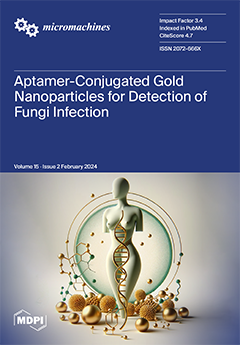Open AccessFeature PaperEditor’s ChoiceArticle
In Vivo Characterization of Intracortical Probes with Focused Ion Beam-Etched Nanopatterned Topographies
by
Jonathan L. Duncan, Jaime J. Wang, Gabriele Glusauskas, Gwendolyn R. Weagraff, Yue Gao, George F. Hoeferlin, Allen H. Hunter, Allison Hess-Dunning, Evon S. Ereifej and Jeffrey R. Capadona
Cited by 1 | Viewed by 2295
Abstract
(1) Background: Intracortical microelectrodes (IMEs) are an important part of interfacing with the central nervous system (CNS) and recording neural signals. However, recording electrodes have shown a characteristic steady decline in recording performance owing to chronic neuroinflammation. The topography of implanted devices has
[...] Read more.
(1) Background: Intracortical microelectrodes (IMEs) are an important part of interfacing with the central nervous system (CNS) and recording neural signals. However, recording electrodes have shown a characteristic steady decline in recording performance owing to chronic neuroinflammation. The topography of implanted devices has been explored to mimic the nanoscale three-dimensional architecture of the extracellular matrix. Our previous work used histology to study the implant sites of non-recording probes and showed that a nanoscale topography at the probe surface mitigated the neuroinflammatory response compared to probes with smooth surfaces. Here, we hypothesized that the improvement in the neuroinflammatory response for probes with nanoscale surface topography would extend to improved recording performance. (2) Methods: A novel design modification was implemented on planar silicon-based neural probes by etching nanopatterned grooves (with a 500 nm pitch) into the probe shank. To assess the hypothesis, two groups of rats were implanted with either nanopatterned (n = 6) or smooth control (n = 6) probes, and their recording performance was evaluated over 4 weeks. Postmortem gene expression analysis was performed to compare the neuroinflammatory response from the two groups. (3) Results: Nanopatterned probes demonstrated an increased impedance and noise floor compared to controls. However, the recording performances of the nanopatterned and smooth probes were similar, with active electrode yields for control probes and nanopatterned probes being approximately 50% and 45%, respectively, by 4 weeks post-implantation. Gene expression analysis showed one gene, Sirt1, differentially expressed out of 152 in the panel. (4) Conclusions: this study provides a foundation for investigating novel nanoscale topographies on neural probes.
Full article
►▼
Show Figures






